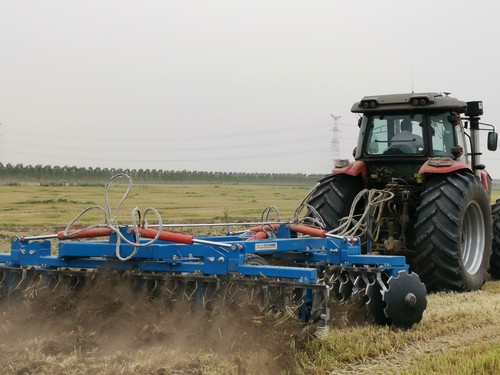The Ultimate Guide to choose the right disc harrow for your farm
- Tim Deng
- March 17, 2023
- 3:44 pm
If you’re looking to prepare your fields for planting, controlling weeds, and improving soil aeration, a disc harrow is an essential tool for any farm. However, choosing the right disc harrow can be a daunting task. There are many factors to consider, such as soil type, tractor horsepower, and the size of your farm. In this guide, we’ll explore everything you need to know to choose the right disc harrow for your farm.

Table of Contents
I. Importance of Choosing the Right Disc Harrow
Choosing the right disc harrow for your farm is crucial to achieving optimal results in seedbed preparation, weed control, and soil aeration. Using the wrong disc harrow can result in poor soil tilth, reduced crop yields, and increased weed pressure. However, choosing the right disc harrow can lead to improved soil health, better crop yields, and reduced weed pressure.
Soil Type and Condition: Soil type and condition are important factors to consider when choosing a disc harrow. Heavy soils require a heavier disc harrow, while lighter soils require a lighter disc harrow. The condition of the soil, such as the presence of rocks or other debris, also affects the choice of disc harrow.
Tractor Horsepower: The horsepower of your tractor is an important factor in choosing a disc harrow. A disc harrow that is too heavy for your tractor can cause strain on the engine, while a disc harrow that is too light can result in poor performance.
Farm Size and Terrain: The size of your farm and the terrain are important factors to consider when choosing a disc harrow. A larger farm may require a larger disc harrow, while rough terrain may require a disc harrow with an offset design.
Desired Level of Seedbed Preparation: The level of seedbed preparation you require will also affect the choice of disc harrow. If you require a finely tilled seedbed, a vertical tillage disc harrow may be a better choice than an offset disc harrow.
Type and Size of Crop to be Planted: The type and size of crop you plan to plant will also affect the choice of disc harrow. For example, crops that require a level seedbed may require a different type of disc harrow than crops that can tolerate a rougher seedbed.
| Type of Disc Harrow | Description | Ideal for |
|---|---|---|
| Offset Disc Harrow | Designed for rough or uneven terrain, with an offset design that allows it to cut through tough soil and debris | Smoothing seedbeds |
| Tandem Disc Harrow | Has two rows of discs that work together to create a smooth seedbed | Larger farms and heavier soils |
| Double Offset Disc Harrow | Has two sets of discs that work independently, allowing for greater flexibility and better performance in rough terrain | Smoothing seedbeds in rough terrain |
| Vertical Tillage Disc Harrow | Works in a more shallow manner, creating a less-disturbed soil surface, ideal for conservation tillage practices and preparing fields for no-till planting | Conservation tillage and no-till planting |
| Combination Disc Harrow | Combines multiple tillage operations into one machine, making it versatile and efficient, can be used for seedbed preparation, weed control, and residue management | Multiple tillage operations |
- Blade size and spacing
- Affects the depth and aggressiveness of the tillage
- Larger blades and wider spacing are better for tougher soils
- Number of disc gangs
- Affects the width of the tillage
- More gangs cover a larger area, but also require more horsepower
- Frame design and material
- Affects the durability and weight of the disc harrow
- Steel frames are more durable but heavier than aluminum frames
- Hitch type
- Determines the attachment point to the tractor
- Different hitch types require different tractor sizes and configurations

V. Maintenance and Safety Considerations
- Proper blade sharpening and replacement
- Maintains the effectiveness of the disc harrow
- Regularly inspect and replace damaged blades
- Lubrication and greasing
- Reduces friction and wear on moving parts
- Regularly lubricate and grease all moving parts
- Storage and transportation
- Protects the disc harrow from weather and damage
- Store in a dry and covered area when not in use
- Safety precautions
- Follow all safety guidelines provided by the manufacturer
- Ensure all guards and shields are in place during operation
VI. Conclusion
Choosing the right disc harrow for your farm is crucial for achieving optimal seedbed preparation and crop yields. Consider factors such as soil type, tractor horsepower, farm size and terrain, desired level of seedbed preparation, and type and size of crop to be planted when selecting a disc harrow. Understanding the different types of disc harrows, their features, and maintenance requirements will also help you make an informed decision. Consult with a reputable dealer and regularly maintain your disc harrow for safe and efficient operation.
